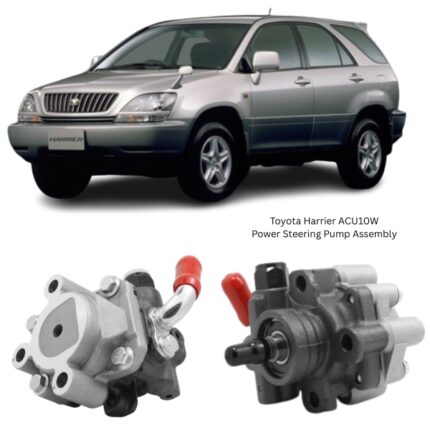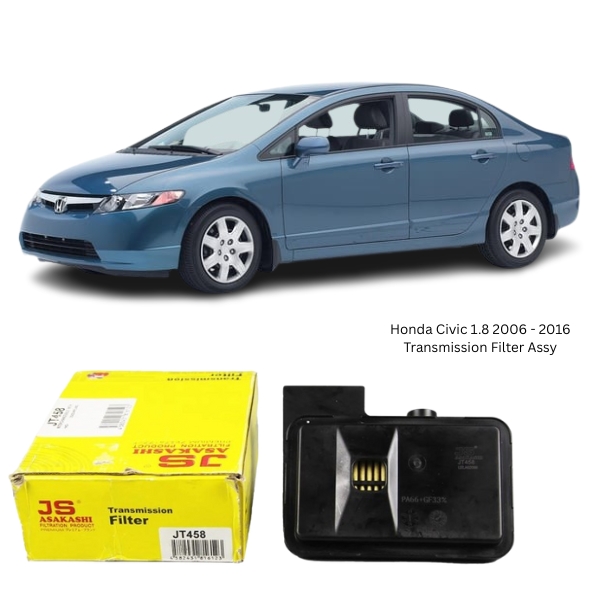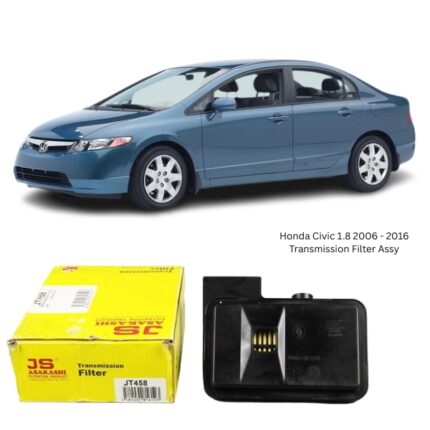Get Honda Civic 1.8 2006 – 2016 Transmission Filter Assy JT458 in Kenya
A Transmission Filter Assembly is a vital component in automatic transmission systems, designed to safeguard the internal components of the transmission by ensuring the fluid remains clean and free of harmful contaminants. It plays a critical role in preserving smooth shifting, maintaining proper hydraulic pressure, reducing component wear, and enhancing the longevity of the transmission.
Over time, debris such as metal particles, friction material, and other contaminants accumulate in the transmission fluid due to normal operation. The Transmission Filter Assembly ensures that these particles are captured before they can circulate and cause damage, making it an essential part of any routine transmission maintenance program.
Purpose and Function of the Transmission Filter Assembly
The primary purpose of the Transmission Filter Assembly is to cleanse the transmission fluid, which is responsible for cooling, lubricating, and powering various components within the transmission system.
Here are its key functions:
-
Filtration of Debris: Captures contaminants such as clutch dust, metal shavings, and worn gasket material that develop over time.
-
Maintaining Fluid Flow: Allows for the smooth flow of clean fluid throughout the transmission’s hydraulic channels, solenoids, and torque converter.
-
Preserving Hydraulic Pressure: Prevents blockages that could lower system pressure and lead to erratic gear shifting or slipping.
-
Enhancing Component Longevity: Protects internal parts like the valve body, gear sets, and bearings from abrasive wear and damage.
By ensuring fluid purity, the filter assembly preserves the operational integrity and responsiveness of the transmission.
Construction and Components
The Transmission Filter Assembly is a precision-engineered unit made from high-quality materials capable of withstanding high pressure, heat, and exposure to transmission fluid over long service intervals.
Typical Components of the Assembly Include:
-
Filter Media:
This is the heart of the assembly, made from high-efficiency synthetic, cellulose, or blended material. It captures contaminants while allowing sufficient fluid flow under varying pressure conditions. -
Rigid Outer Housing:
The body of the assembly is made from heat-resistant plastic or stamped steel, designed to handle prolonged exposure to fluid and elevated temperatures inside the transmission. -
Sealing Components (O-Rings and Gaskets):
Integrated rubber or elastomeric seals prevent fluid bypass and ensure that all transmission fluid flows through the filter element. -
Pick-up Tube or Neck (if included):
Draws fluid from the transmission pan and directs it into the filter. Proper sizing ensures the transmission pump receives a steady, uninterrupted flow of fluid. -
Drainback Valve (in some designs):
Prevents fluid from draining out of the torque converter when the engine is turned off, helping reduce delays in gear engagement during startup.
All components are built for durability and resistance to chemical breakdown, ensuring optimal performance throughout the filter’s lifespan.
Performance Benefits
Installing a quality Transmission Filter Assembly provides numerous operational and long-term benefits:
-
Cleaner Transmission Fluid:
Prevents contamination-related wear by ensuring only clean fluid circulates through the system. -
Improved Gear Shifting:
Prevents erratic or harsh shifting caused by fluid flow restrictions or dirty solenoids. -
Extended Component Life:
Clean fluid reduces friction and heat, helping key components like clutches and valve bodies last longer. -
Protection Against Overheating:
Proper fluid circulation and filtration aid in cooling, preventing thermal damage to the transmission. -
Reduced Maintenance Costs:
Prevents internal damage that may lead to expensive repairs or full transmission replacement. -
Enhanced Vehicle Reliability:
Ensures consistent performance, especially under high-load or high-temperature conditions.
These advantages make regular inspection and replacement of the filter assembly an important preventative measure.
Symptoms of a Faulty or Clogged Transmission Filter Assembly
A worn or clogged filter can compromise the entire transmission system. Common symptoms include:
-
Delayed Engagement of Gears:
Slow shifting into drive or reverse, especially when cold, can indicate a restriction in fluid flow. -
Slipping Transmission:
Low or unstable hydraulic pressure caused by a blocked filter may lead to the transmission slipping during acceleration. -
Unusual Noises:
Whining, buzzing, or growling sounds during gear changes or while idling can be a sign of restricted fluid passage or cavitation at the pump. -
Burnt or Discolored Transmission Fluid:
Dark, dirty, or burnt-smelling fluid often results from poor filtration and fluid degradation. -
Overheating Transmission:
If the fluid can’t circulate efficiently, the transmission may overheat, triggering warning lights or performance degradation. -
Check Engine or Transmission Warning Light:
In many modern systems, diagnostic codes may indicate solenoid pressure or valve body issues stemming from dirty fluid.
Addressing these signs early by replacing the filter can prevent serious damage and ensure continued smooth operation.
Installation and Replacement Overview
Replacing a Transmission Filter Assembly is typically done as part of a routine transmission service, along with fluid replacement and gasket inspection.
Basic Installation Steps:
-
Lift and Secure the Vehicle:
Ensure safe and level access to the transmission system. -
Drain the Transmission Fluid:
Use the designated drain plug or carefully loosen the transmission pan bolts to allow fluid to drain. -
Remove the Transmission Pan:
Clean the pan thoroughly and inspect for debris, such as metal shavings or excessive clutch material. -
Remove the Old Filter Assembly:
Unscrew or unclip the existing filter. Remove any old O-rings or seals to prevent leaks. -
Install the New Filter Assembly:
Seat the new filter and ensure all seals are properly in place. Torque bolts according to specifications. -
Replace the Pan Gasket and Reattach the Pan:
Use a new gasket to prevent leaks. Torque the pan bolts evenly in a cross-pattern. -
Refill Transmission Fluid:
Add the appropriate type and volume of transmission fluid, checking the dipstick after warm-up. -
Test Drive and Recheck Fluid Level:
Cycle through all gears with the engine running. Adjust fluid level as needed.
Always follow manufacturer specifications and use compatible fluid types for optimal results.
Maintenance Tips
To extend the lifespan of the transmission and ensure the filter assembly continues functioning correctly, consider these best practices:
-
Follow Service Intervals:
Replace the filter every 40,000–80,000 kilometers, or as recommended by the transmission system’s specifications. -
Inspect Fluid Regularly:
Check for changes in fluid color, odor, or level, which may signal problems with filtration or internal wear. -
Avoid Aggressive Driving with Cold Fluid:
Allow the vehicle to warm up, especially in cold environments, to prevent internal pressure spikes. -
Address Symptoms Promptly:
Early intervention when symptoms appear can save you from expensive repairs later. -
Use OEM-Quality or Better Components:
A poorly manufactured filter can collapse or allow contaminants to pass through, compromising the transmission.
Follow us on Facebook for more parts.





Reviews
Clear filtersThere are no reviews yet.